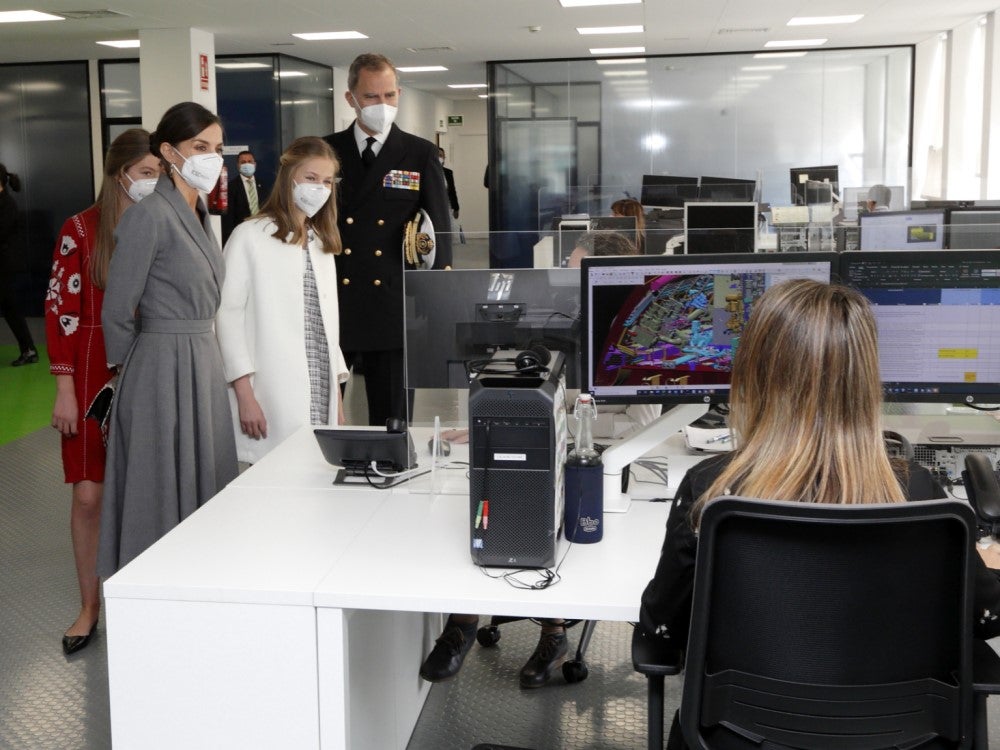
His Majesty King Felipe VI, accompanied by Her Majesty the Queen, Her Royal Highness the Princess of Asturias and Her Royal Highness Infanta Sofia, has presided over the launching ceremony of S-81, the first submarine of S-80 class, in Navantia shipyard in Cartagena, Murcia, Spain.
Her Royal Highness the Princess of Asturias sponsored the submarine. As the maritime tradition demands, Her Royal Highness has cut the ribbon that activates the mechanism and smashes the bottle. Prior to the ceremony, Their Majesties and Their Royal Highnesses have visited the Engineering unit of the shipyard and its Virtual Design Centre (CDV).
With S-80 programme, Spain becomes one of the few countries that can design and build submarines, an extremely complex task because these vessels must operate autonomously in a hostile environment. Therefore, represents a strong commitment with national technological development, and thus, with national defence as well as with the international positioning of Spanish industrial sector.
The launching ceremony has been attended by the Minister of Defence, Margarita Robles; the President of Región de Murcia, Fernando López Miras; the Chief of the General Staff (JEMAD), Almirante General Teodoro López Calderón and the Admiral Chief of Staff of the Navy (AJEMA), Almirante General Antonio Martorell Lacave, as well as the President of Navantia, Ricardo Domínguez and the President of the Spanish State-owned holding (SEPI), Belén Gualda, among other authorities.
The S-80 programme is the greatest industrial and technological challenge ever faced by the national defence industry. Navantia is taking a huge technological step forward, as it is taking the role of Technical Design Authority for the first time. In addition, Navantia is completing the cycle of technological evolution: from building in Spain with a foreign design to building in Spain with Spanish design.
The ceremony, which has been held under health and safety precautions due to the current health situation, has taken place days ahead of the process of setting the submarine afloat. This process, which takes long hours, will be carried out by shipyard staff as a routine of work in the following week.
The next phases will be harbour tests and sea tests, which include sailing up to the maximum operating depth. The first sailing is scheduled for early 2022 and delivery to the Navy in early 2023.
Navantia’s President has expressed his gratitude to the Ministry of Defence and the Navy for their ‘committed and unwavering support they have given to the programme, in view of its strategic importance for Spain’. He has also commended the workers of the company and the collaborating industry as a great example of Spain technological capabilities.
Ricardo Domínguez has underlined that the S-80 class ‘gives a major boost to Spanish industry and puts Navantia firmly in the forefront giving the firm a major international profile with many opportunities in other countries’. Navantia expects to repeat the successes obtained with the F-100s and the ‘LHD’ amphibious assault ships.
The Admiral Chief of Staff of the Navy has underlined that ‘the submarine is proof of Spanish industrial capacity and its firm commitment to technological innovation’. He has added that ‘the S-80 provides the Navy, along with the projection capacity represented by the amphibious ships, marine infantry and embarked aviation, the escorts and the maritime action force, the means that makes it relevant in the international context’.
Finally, the Minister of Defence has defined today as a historic day for Spain. She has said that the submarine means ‘science, innovation, technology, it is the future’ and has recognised the work and effort of all those who have made possible the S-81, which she has described as a ‘masterpiece’.
The S-80 submarines have an overall length of 80.8m, a diameter of 7.3m and a submerged displacement of around 3,000t. They include the integrated combat system and platform control system developed by Navantia Sistemas. They will have BEST-AIP, an atmosphere-independent propulsion system, which supplies the ship with electrical power at any depth so that it can remain underwater for longer periods.
Therefore, S-80 has improved considerably its stealth capabilities, the main attribute of a submarine. The S-80 stands as the world’s most advanced conventional submarines and has drawn the attention of several navies and opened opportunities in a highly technological international market.

